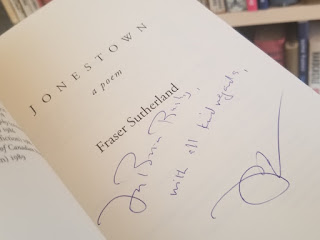Arthur Stringer
Arthur Stringer's first novel, 1903's The Silver Poppy, concerns a young woman named Cordelia Vaughan who passes off a manuscript left by a dead man as her own. When published, the stolen work tops the bestseller lists, and its supposed authoress becomes the toast of Manhattan The narrator of The Silver Poppy, English poet John Hartley, discovers Cordelia's fraud, but is too much of a gentleman to destroy her life.
The Silver Poppy was one of my favourite reads of 2019.
I thought of The Silver Poppy often when reading The Devastator, Arthur Stringer's final novel. It too features a male narrator who becomes enmeshed in the life of a seemingly successful female novelist. This time out, the novelist is authentic.
Sibyl Sencourt is not quite the woman Ruxton was expecting; petite and practical, there's a whiff of tweed about her. In the months following their meeting on the wharf, they share nothing more than two unmemorable lunches, which accounts for Ruxton's initial surprise by Sibyl's request that he accompany her to a New Year's Eve celebration. Things soon become clear:
What she wanted, she explained, was a first-hand picture of that bacchanalian American evening in one of New York's most bacchanalian hotels. And if I would shepherd her through that night of tumult she'd expect, in the circumstances, to pay all costs.On the evening in question ‐ 31 December 1939 ‐ the attorney is gobsmacked when Sibyl appears made-up and dressed-up in a low-cut gown. She's definitely on the prowl, but only for material. "It was more ink than wine we spilled that night," Ruxton reports, noting that his date spent the evening observing others, often removing a fountain pen and pad from her clutch in order to jot down a sentence or two.
The authoress's investment in a New York New Year's Eve pays off when a highly-spirited man commands the attention of a neighbouring table. He's Leo Ortell, a handsome, charismatic, self-absorbed, showy, dimwitted Hollywood actor who just happens to be one of Ruxton's clients. In the recent past, the attorney has had to "untangle him from a couple of petticoats." Sibyl is intrigued, seeing in Ortell the inspiration for her next novel, and so follows the actor west by taking a job in Hollywood. Months pass. Ruxton hears nothing from Sibyl until she reappears in New York for a Book-of-the-Hour Club launch. There she tells Ruxton that she must get closer to Ortell to write her novel, and so is set on marrying the actor. "You mean," says the attorney, "that you want to carry the watch home and take it to pieces and find out just what makes it tick."
"It's a wonderful book, Ruxton... And it's going to top everything Sibyl's already done.""What's it about?" I was foolish enough to ask."It's about a two-legged vampire who feeds on the flesh of every friend he ever had. You understand ‐ a character study. He thinks he'd a mental wonder, while all the time masquerading as a moron ‐ just a shop window if you get what I mean."I proffered the opinion that it wasn't easy to make morons interesting."But that's where Sibyl's a wonder, maintained her husband. "She turns him inside out and makes him so real you carry away the feeling he must have lived in the next block to you."I still wonder why some spirit of perversity should have prompted me to question: "Then who's the model?"I caught Sibyl's imploring look, and catching it, was glad Ortell had not seen it.She had none," he triumphantly proclaimed. "The bounder came out of her head. But I can't understand why she doesn't get busy and wind things up."
Sadly, just as The Devastator looks about to take flight, it takes an unexpected turn, skids about, and comes to a choking halt.
Against character, Ortell decides to join the war effort. Older than the average serviceman, the actor is rejected by the Air Force, the Navy, and the Army, but is somehow accepted in the Marines, becoming a member of the 1st Battalion, otherwise known as Edson's Raiders.
Here I note that the author's son, Hugh Arthur "Barney" Stringer (1919-2002), served as one of the Raiders. In fact, The Devastator is dedicated to the man:
They're not bad ‐ "Genius seems to be the faculty of having faith in everything, and especially one's self," for example ‐ though one wonders why they go on and on and on. My theory is that, at age seventy, Stringer saw The Devastator as perhaps his last opportunity to set in print pithy notes he'd made but had never used.
I may be wrong.
Either way, would that I had his stamina!
I always have.
Access: Library and Archives Canada has a copy, as does the Toronto Public Library, the London Public Library, the Chatham-Kent Public Library, the Vancouver Public Library, and eleven of our universities.
Only one copy is currently listed for sale online. Price: US$23.00 (w/ US$30.00 shipping!). A library discard, sans dust jacket, it is not recommended. Give it a pass. You can do better.






































